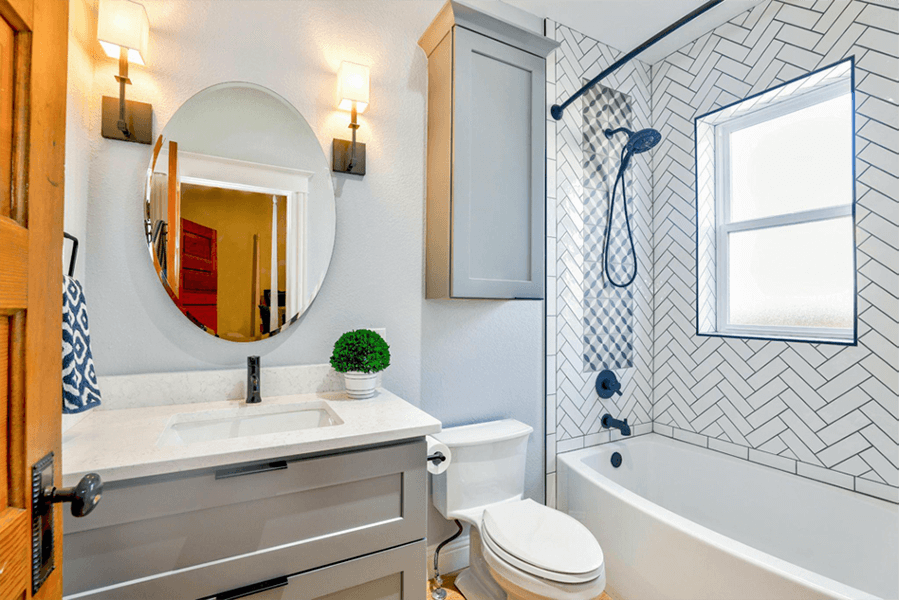Revive your shower and give it a fresh new look with our step-by-step guide to regrouting like a pro. Over time, the grout in your shower can become stained, cracked, or discolored, diminishing the overall appearance of your bathroom. But don’t worry, with our expert tips, you can easily transform your shower into a sparkling oasis.
In this comprehensive guide, we’ll walk you through each stage of the regrouting process, from preparing the surface to applying the new grout. Our easy-to-follow instructions, accompanied by detailed illustrations, will ensure that even novice DIY enthusiasts can achieve professional-looking results.
Whether you’re dealing with mildew-infested grout, loose tiles, or simply want to update the style of your shower, this guide has got you covered. Say goodbye to dirty grout lines and hello to a revitalized bathroom that feels brand new.
Follow our step-by-step guide to regrouting like a pro and say hello to a shower you can be proud of!
Signs that your shower needs regrouting
If your shower grout is showing signs of wear and tear, it may be time to consider shower regrouting. Here are some common signs that indicate your shower needs attention:
- Stained or Discolored Grout: Over time, grout can become discolored due to the build-up of dirt, soap scum, and mold. If your grout looks yellowed, brown, or gray instead of its original color, it’s time to refresh it
- Cracked or Missing Grout: Cracked or missing grout can lead to water seepage, which can cause damage to the underlying structure of your shower and lead to mold growth. If you notice cracks or gaps in your grout lines, it’s important to address them promptly.
- Loose or Detached Tiles: If you notice tiles that are loose or coming off the wall, it’s a clear sign that the grout holding them in place has deteriorated. Regrouting will not only improve the appearance of your shower but also ensure the tiles are secure.
- Grout removal tool: A grout removal tool, such as a grout saw or an oscillating tool with a grout removal blade, will help you remove the old grout from between the tiles.
- Safety goggles and gloves: Protect your eyes and hands from flying debris and chemicals by wearing safety goggles and gloves throughout the process.
- Grout scraper: A grout scraper will come in handy for removing any stubborn grout residue after using the grout removal tool.
- New grout: Choose a high-quality grout that is suitable for your shower environment. Consider factors such as color, water resistance, and ease of application.
- Grout float: A grout float is a tool used to spread the new grout evenly and efficiently into the grout lines.
- Sponge and bucket of water: You’ll need a sponge and a bucket of water to clean the tiles and remove excess grout during the application process.
- Grout sealer: A grout sealer will help protect your new grout from stains and moisture, extending its lifespan.
- Preparation: Start by cleaning the shower tiles thoroughly to remove any surface dirt or soap scum. This will make it easier to see the grout lines and ensure a better bond between the new grout and tiles.
- Safety precautions: Put on your safety goggles and gloves to protect yourself from flying debris during the grout removal process.
- Using the grout removal tool: Hold the grout removal tool at a slight angle and apply gentle pressure to the grout lines. Move the tool back and forth along the grout lines to remove the old grout. Be careful not to chip or damage the tiles.
- Cleaning up: After removing the old grout, use a grout scraper to remove any remaining grout residue from the tile surfaces. Wipe away the debris with a damp cloth.
- Inspecting for completeness: Inspect the grout lines to ensure all the old grout has been removed. Any remaining grout can interfere with the adhesion of the new grout.
- Clean the tiles: Before applying the new grout, clean the tiles thoroughly using a non-abrasive cleaner. This will remove any remaining grout dust or residue from the removal process.
- Drying time: Allow the tiles to dry completely before proceeding. Moisture on the surface can prevent proper adhesion of the new grout.
- Masking off: If you want to protect the surrounding areas from accidental grout smears, use painter’s tape to mask off the edges of the tiles.
- Removing excess caulk: If there is any old caulk present, remove it using a caulk removal tool. This will ensure a clean and seamless finish.
- Mixing the grout: Read the manufacturer’s instructions on the grout packaging and mix the grout accordingly. Use a mixing paddle attached to a drill for a smooth and consistent mixture.
- Applying the grout: Use a grout float to apply the grout onto the tiles. Hold the float at a 45-degree angle and firmly press the grout into the grout lines. Work in small sections to ensure the grout doesn’t dry out before you can clean it.
- Cleaning the excess grout: After applying the grout, use a damp sponge to wipe away the excess grout from the tile surfaces. Rinse the sponge frequently to avoid smearing the grout.
- Finishing touches: Use a grout finishing tool to smooth and shape the grout lines, giving them a professional look. This step will also help remove any excess grout that may have been missed during the cleaning process.
- Drying time: Allow the new grout to dry and cure according to the manufacturer’s instructions. This usually takes around 24 to 48 hours.
- Cleaning the grout: Once the grout is fully dry, use a grout cleaner and a soft brush to gently scrub the grout lines. This will remove any haze or residue left behind during the installation process.
- Sealing the grout: Apply a grout sealer to protect the new grout from stains and moisture. Follow the manufacturer’s instructions for application and drying time.
- Regular maintenance: To keep your grout looking its best, regularly clean the shower tiles and grout with a mild cleaner and a soft brush. Avoid using abrasive cleaners or tools that can damage the grout.
- Regular cleaning: Clean your shower regularly to prevent the build-up of dirt, soap scum, and mold. Use a mild cleaner and a soft brush to scrub the tiles and grout.
- Dry the shower: After each use, wipe down the shower walls and floor with a squeegee or towel to remove excess water. This will help prevent moisture from seeping into the grout lines.
- Ventilation: Ensure proper ventilation in your bathroom by using an exhaust fan or opening a window during and after showering. This will help reduce humidity and prevent mold growth .
- Reapply grout sealer: Periodically reapply grout sealer to maintain its protective properties. Follow the manufacturer’s instructions for reapplication frequency.
By keeping an eye out for these signs, you can catch grout issues early and prevent further damage to your shower.
Tools and materials needed for regrouting
Before you begin the regrouting process, it’s essential to gather the necessary tools and materials. Here’s a list of what you’ll need:
Make sure you have all the necessary tools and materials before you start regrouting to ensure a smooth and efficient process.
Step-by-step guide to removing old grout
Removing the old grout is an essential first step in the regrouting process. Here’s a step-by-step guide to help you tackle this task:
By following these steps, you’ll have a clean slate ready for the application of new grout.
Preparing the surface for regrouting
Preparing the surface is crucial to ensure the new grout adheres properly and lasts for years to come. Follow these steps to prepare your shower for regrouting:
By taking the time to prepare the surface properly, you’ll enhance the longevity and appearance of your regrouted shower.
Mixing and applying new grout
Now that the surface is prepared, it’s time to mix and apply the new grout. Follow these steps for a successful application:
By following these steps, you’ll achieve clean and even grout lines that will transform the appearance of your shower.
Properly cleaning and sealing the new grout
Cleaning and sealing the new grout is essential to ensure its longevity and prevent stains and moisture damage. Here’s how to properly clean and seal the new grout:
By properly cleaning and sealing the new grout, you’ll ensure its longevity and maintain a clean and fresh appearance in your shower.
Tips for maintaining and preventing future grout issues
To keep your newly regrouted shower looking its best and prevent future grout issues, follow these shower regrouting tips:
By following these maintenance tips, you’ll prolong the life of your regrouted shower and prevent future grout issues.
Hiring a professional for regrouting services
While regrouting can be a DIY project, it may not be suitable for everyone. If you’re not confident in your DIY skills, have a large or complex shower, or simply prefer to leave the job to the professionals, consider hiring a professional regrouting service.
A professional regrouting service will have the expertise and experience to handle any grout issues in your shower. They will ensure a high-quality and long-lasting result, saving you time and effort.
When choosing a professional regrouting service, do your research and read reviews to find a reputable and experienced company. Get multiple quotes and ask for references to ensure you’re making an informed decision.
Conclusion
Reviving your shower with a fresh new grout is a rewarding DIY project that can transform the appearance of your bathroom. By following our step-by-step guide to regrouting like a pro, you’ll be able to tackle the task with confidence and achieve professional-looking results.
From removing the old grout to properly cleaning and sealing the new grout, each stage of the regrouting process is essential to ensure a long-lasting and visually appealing finish. By taking the time to properly prepare the surface, mix and apply the new grout, and maintain the grout lines, you’ll enjoy a revitalized shower that feels brand new.
Whether you choose to tackle the project yourself or hire a professional regrouting service, investing in the appearance and maintenance of your shower will enhance the overall aesthetic of your bathroom and create a more enjoyable bathing experience.
Follow our step-by-step guide to regrouting like a pro and say goodbye to dirty grout lines and hello to a shower you can be proud of!






